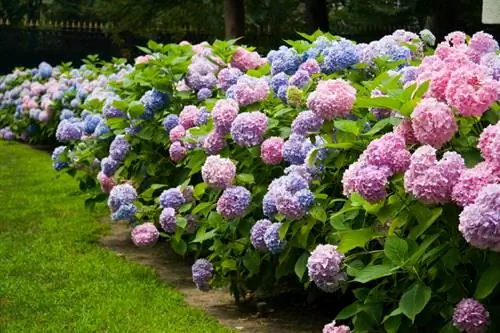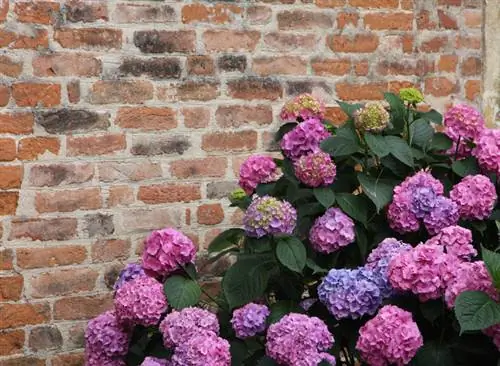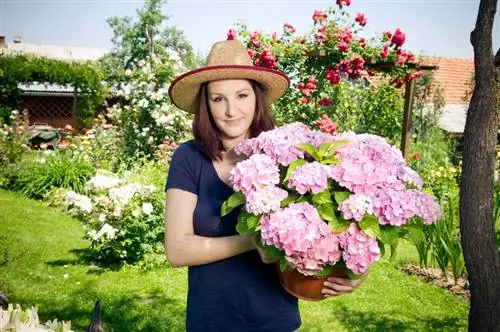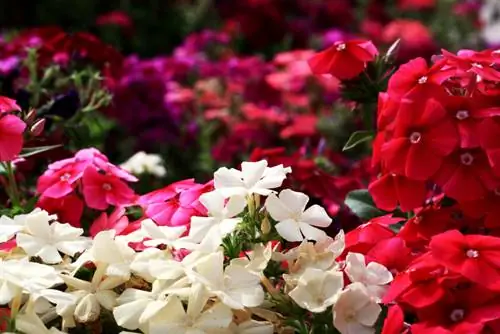- Author admin [email protected].
- Public 2023-12-25 17:45.
- Last modified 2025-06-01 06:02.
In beds and pots, the farmer's hydrangea sets picturesque accents with lush flower balls. To ensure that the summer flowering shrub maintains its vitality for many years, important questions about its cultivation come into focus. Well-founded answers clear up any confusion about the garden hydrangea.
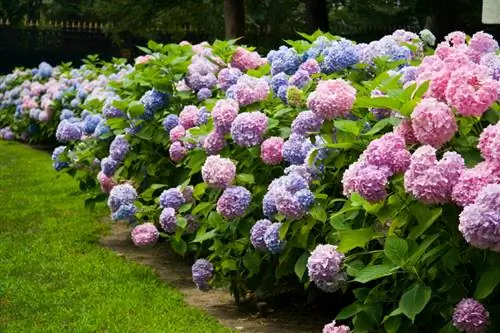
How do you properly care for a farmer's hydrangea?
Farmer hydrangeas require a partially shaded location with a humid climate and sheltered from the wind as well as a nutrient-rich, humus-rich and slightly acidic soil. Care includes regular watering, fertilizing and careful topiary in spring. Protect them from frost in winter.
Planting farmer's hydrangea correctly
Proper soil preparation paves the way for the best growth and abundant flowering. Loosen the soil deeply at the chosen location and remove roots and stones. Dig a pit with twice the volume of the root ball and fill it with fresh ericaceous or rhododendron soil. This is how the planting continues:
- Soak the still potted root ball in water until no more air bubbles appear
- Unpot, place in the middle of the pit and pour in
Finally, spread a 5 centimeter high layer of mulch, such as leaf mold, needle compost or bark mulch.read more
Care tips
The care of farmer's hydrangeas is dominated by a high need for water and nutrients, in conjunction with an acidic, preferably lime-free acid and alkaline content of the soil. The care program in brief:
- Watering once or twice a day with soft water
- Fertilize organically or mineral-organically from March to September
- In winter, pile up with leaves, needles or straw
- Reduce watering and do not fertilize
- Cut withered flower heads in spring, thin out dead wood and 5-year-old branches
- Buds protect against delayed ground frosts with fleece
Farmer hydrangeas in pots move to a frost-free winter quarters with temperatures around 5 degrees Celsius, like an unheated stairwell.read more
Which location is suitable?
The ideal location for a farmer's hydrangea is partially shaded, humid and protected from the wind. The ornamental tree reaches its optimum under the canopy of deciduous trees. Where a sufficient water supply is guaranteed, the garden hydrangea tolerates a sunny location.read more
The correct planting distance
The rule of thumb is: the planting distance corresponds to half the growth width. The majestic variety 'Alpenglühen' grows up to 120 cm wide, so a planting distance of 60 cm is the right choice. The slimmer 'Mathilde Gütges' with a growth width of 100 cm is planted at a distance of 50 cm.
What soil does the plant need?
Plant a farmer's hydrangea only in nutrient-rich, humus-rich and loose soil with a slight moisture content. An acidic pH value of 5 to 6 is essential, for blue varieties it is 3.5 to 4. We therefore recommend using special rhododendron or ericaceous soil for pot cultivation.
What is the best time to plant?
The time window for planting a farmer's hydrangea opens in May, when the ice saints have said goodbye. Until then, delayed ground frosts could cause damage to the ornamental tree.
When is flowering time?
The flowering period of the classic varieties extends from July to October. Modern varieties have the potential to bloom on old and young wood. Therefore, when the weather is mild, these garden hydrangeas delight us with their blooms from May onwards, which last until September/October.read more
Cut farmer's hydrangea correctly
Exercise restraint when cutting a farmer's hydrangea. The older the flowering bush, the less it tolerates extensive pruning. How to do it right:
- Cut off the withered flowers in early spring
- Make the cut just above the first strong bud
- Cut branches that are more than 5 years old and the dead wood close to the ground
The innovative breeding 'Endless Summer' occupies a special position. Since this garden hydrangea blooms on both last year's and this year's wood, it doesn't mind extensive pruning. Regardless, the flower beauties should not be cut any more than absolutely necessary.read more
Watering the farmer's hydrangea
The botanical name Hydrangea already indicates the high water requirement of a farmer's hydrangea. Water daily, even if it has rained. On hot summer days, it is best to water early in the morning and late in the evening. Avoid watering the plant, but rather give the water directly to the roots without causing waterlogging. The softer the water, the more beneficial for the he alth and color of a garden hydrangea.
Fertilize farmer's hydrangeas properly
In the period from March to September, the nutrient requirements of a farmer's hydrangea are at a high level. You can ensure a balanced nutrient supply using the following organic or mineral-organic fertilizers:
- Provide leaf or needle compost every 14 days, supplemented with horn shavings and coffee grounds
- Alternatively, apply organic hydrangea fertilizer Azet from Neudorff (€7.00 at Amazon) or Compo every 4 weeks
- Administer mineral-organic long-term fertilizer from Substral, Compo or Beckmann in March and July as granules or liquid
In addition, specialist retailers offer organic-mineral fertilizers with bluening agents, which ensure a long-lasting blue flower color.read more
Diseases
A farmer's hydrangea weakened by improper care is susceptible to powdery mildew. If a mealy-white patina covers the magnificent hydrangea foliage during the summer, fungal spores have settled here. In the early infestation stage, the classic milk-water solution in a ratio of 1:9 works. Be sure to cut off infected foliage and dispose of it in the trash.
Pests
The farmer's hydrangea occasionally gets into trouble with the following pests:
- Aphids: destroy with 30 grams of pure soap, dissolved in 1 liter of water with a dash of spirit
- Spider mites: fight with a biological insecticide based on rapeseed oil
A spider mite infestation occurs particularly when overwintering is too warm. If you place the farmer's hydrangea cooler at 4-6 degrees, it will be too uncomfortable for the pests.
Wintering
The farmer's hydrangea only acquires robust winter hardiness when it is older. Until then, the flowering tree receives the following winter protection every year:
- Cover the root area with leaf mold, straw and needle twigs
- In rough locations, also cover the shoots with jute or reed mats
- Wrap the bucket in bubble wrap and place it on wood in front of the south wall
- Put a felt bag over the branches (no foil)
The threat to young buds from late frosts remains throughout the entire lifespan of a farmer's hydrangea, so increased attention and caution is required until mid-May.read more
Propagate farmer's hydrangea
The vegetative propagation of a farmer's hydrangea scores with pure breeding and uncomplicated handling. The following two methods are available:
- Cut cuttings in July, plant in poor soil and keep constantly moist until rooting
- Pull the sinker to the ground, score the middle area, dig in and leave to root until next year
The cuttings will propagate more quickly if you place the pot under a transparent hood and ventilate it briefly every day. To gently remove the delicate root system of a sinker from the ground, simply sink a flower pot into the ground next to the mother plant, fill it with peat sand and fix the shoot part in it.read more
How do I transplant correctly?
A well-chosen date for relocating a farmer's hydrangea is a mild day in April so that the tree can take root again until the next winter. 2-3 weeks beforehand, cut off the root ball all around with a spade, with the radius corresponding to the growth height of the garden hydrangea. Water the plant thoroughly and repeatedly until the day of transplanting. Follow these steps:
- Loose the root ball and lift it out of the ground
- Do not plant deeper in the new location than before
- Water abundantly and mulch with leaf compost
read more
Farmer hydrangea in a pot
No other type of hydrangea is as perfect for pot cultivation as the farmer's hydrangea. Use ericaceous or rhododendron soil as a substrate and place a drainage layer made of pottery shards underneath to protect against waterlogging. Keep the flowering tree constantly moist in a partially shaded spot. From March to September, fertilize every 14 days with an extra liquid fertilizer for hydrangeas.
In time before the first frost, take the potted hydrangea to a dark winter quarter with temperatures around 5 degrees. Since the garden hydrangea has shed its leaves, it receives less water and no fertilizer. When the first buds sprout, place the plant in partial shade and a little warmer.
Farmer hydrangea not blooming
If a farmer's hydrangea fails to bloom, delayed ground frost is usually responsible for the deficiency. Therefore, protect the frost-sensitive buds with jute or garden fleece until the danger after the ice saints and the cold sheep has passed. In addition, a garden hydrangea will not bloom if you cut it back in the fall.read more
Yellow leaves
A farmer's hydrangea with yellow leaves is suffering from leaf chlorosis. The cause of the damage is the use of calcium-containing irrigation water or unsuitable fertilizers. Basically, water with collected rainwater and apply organic, acidic leaf compost or special hydrangea fertilizer from specialist retailers.
How do I turn a pink hydrangea blue?
The secret of changing the color from pink to blue is based less on magic than on the pH value of the soil of 4.0 to 4.5. To create this value, you don't need to use the chemistry kit. This is how the color transformation can be achieved in no time at all:
- Ask the pharmacy for potassium aluminum sulfate - alum for short
- In addition to normal fertilization, give the farmer's hydrangea 20-80 grams of alum from March to July
- Repeat the administration of alum until the desired blue color occurs
In the bucket, the coloring from pink to blue is quicker due to the narrow substrate volume. You can increase the effect if you dissolve alum in boiling water and add a splash of vinegar. It is essential to avoid contact of the preparation with the flowers and leaves. By the way, this trick doesn't work on white-flowering garden hydrangeas.
Cut off the faded flowers or should you not?
Creative hobby gardeners leave the wilted flower balls on a farmer's hydrangea throughout the winter. Covered with glittering frost and snow, the paper balls drive away the melancholy of winter from the otherwise deserted garden. In February/March, cut off the withered flowers to make room for the next generation.read more
The most beautiful varieties
- Hamburg: the variety impresses with large, pink flower balls and reddish foliage
- Holibel: fantastically beautiful farmer's hydrangea with white porcelain flowers and robust winter hardiness
- Bela: a classic for the rural garden with huge flowers in light blue, stable and very vigorous
- Hot Red: the tried and tested garden hydrangea with strong red flowers from June to September
- The Bride: white-flowering new variety from the innovative Endless Summer line

